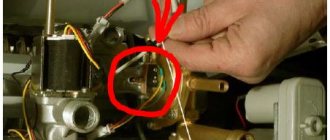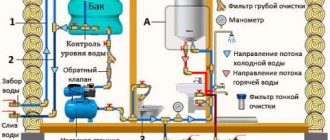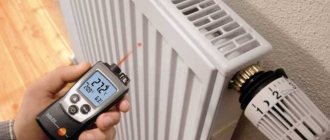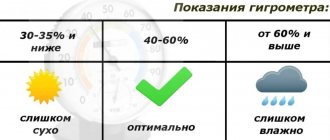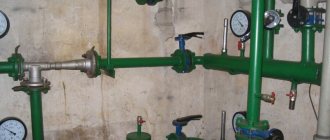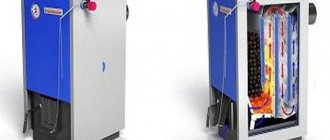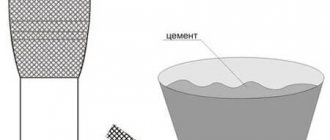Types of boilers
Initially, it is worth deciding on the type of boiler, since this is the main element of the system. First of all, boilers are divided according to the type of fuel. It is on this principle that they should be chosen:
- solid fuel.
The boiler runs on wood, coal, briquettes, pellets. - liquid fuel
The boiler runs on diesel fuel. - electric.
The boiler runs on electricity. - gas.
The boiler runs on natural or liquefied gas.
If your private house is located in a gasified area, we recommend that you organize a water supply and heating system using a double-circuit gas boiler. Today, such systems are quite automated and completely safe.
Selecting the type of heating system
At the very beginning of the heating organization, a boiler is selected and purchased. Here we will not disassemble stoves that run on solid fuel, wood, waste oil, or diesel fuel. Usually, with their help, it is not possible to create heating and hot water supply in one system, and a lot of money is required.
If your location does not have a gas network, and there are often interruptions in electrical energy, then it is advisable to use methods where instead of a heating source they install solid fuel boilers, otherwise there is a chance of freezing in your home in winter. Let's consider the most common heating and hot water supply systems for a private home, powered by electricity or gas.
Gas boilers
Such devices are divided into several popular types:
- Floor-standing boilers with an expansion tank (AOGV) are used for autonomous operation. It is not suitable for heating water for domestic use. Their advantage is their autonomy; they do not require electricity to operate. The negative aspects include not very economical gas consumption, and poor build quality and automatic systems in cheap models.
Floor-standing boilers - Wall-mounted boilers with chimney and electronic control system. Usually these are efficient and economical devices with high efficiency. Water enters the radiators using an internal or external pump. This can be called a disadvantage and an advantage. In many cases, these boilers are not able to operate without electricity. Hot water supply to a private home for the kitchen or bathroom is supplied through a secondary circuit.
Wall-mounted boilers with chimney and electronic control system - Turbocharged wall-mounted boilers are also a good option with high efficiency. Thanks to the turbine, such boilers can be installed anywhere in the room. It does not require a chimney. The negative factor is the same as in the previously discussed case. If there is no electricity, then the automation will not work, along with the turbine.
Turbocharged wall-mounted boilers
If you need to buy a gas-powered boiler that is independent of electricity and at the same time economical, then it is better to purchase an additional power source for it, which will ensure an uninterrupted supply of electricity. It is a battery that powers the automatic system when there is no electrical energy in the network.
We figured out gas boilers as a heating source. Now we need to consider how to organize the supply of hot water. It is necessary to use a double-circuit boiler or an auxiliary gas water heater. Usually its cost is several times less than the boiler itself, so purchasing a column will not put too much of a strain on the family budget.
Electric boilers
There are also a great many such devices in the retail network today. They can heat large areas of premises. But their effectiveness and cost are still a problematic topic. This type of boiler is usually purchased if it is not possible to use gas, or as a backup option if gas equipment fails in winter.
These recommendations are based on the following:
- An electric boiler consumes a lot of electricity, which significantly affects the well-being of the residents of the house.
- Even expensive electric boilers usually have low efficiency. This means that in severe frosts and a poorly insulated house, the boiler will slowly warm up the water. In this situation, a gas boiler works much more efficiently; it heats the cold water in the system very quickly.
Electric boilers have their own scope of application, but if you need to heat large areas, then the following factors should be taken into account:
- The house needs to be well insulated.
- Electrical energy for heating is much more expensive than gas fuel. Therefore, if you have to use electricity, it is better to try to get some discounts or subsidies.
- If the electricity is often cut off and there is no gas, then problems will arise with heating. For such situations, there are combined boilers that run on liquid and solid fuel.
Electric boilers have a great advantage - they can be connected independently, without permits, unlike a gas boiler. You can simply connect an electric boiler to the electrical network, but you should make sure that there is sufficient power reserve in the meter, protection devices and electrical wiring. If this equipment is of insufficient quality and power, then the boiler will not be able to operate normally, and there is no question of safety.
If we consider hot water supply and heating in one equipment, then there is little choice. Hot water supply will be provided by a second circuit, or you will have to purchase another boiler or electric heater.
Let's consider such an important factor, which radiators to choose in a retail chain. Then we will find out the principle of installing the system.
The simplest system
A similar (DHW) hot water supply system in a house is a single circuit through which water circulates naturally. Another name for the installation is gravity, since water moves through the pipeline under the influence of its own mass. Such solutions are used where there is often no electricity for pumps. It happens that the pump is still installed, but if an emergency situation occurs (the pump is turned off), then the movement of the coolant does not stop. That is, the system continues to work even if there is a power outage.
Pros of the system:
- easy installation.
- easy operation.
- due to the absence of a pump, there is no noise during system operation.
- autonomy.
- wear resistance.
- durability.
Installation disadvantages:
- The dimensions of a country house should not be more than 100 sq.m.
- a single contour in a horizontal plane should not exceed 30 m in length.
- Possible freezing of water. Because of this, pipes that are at risk should be seriously insulated.
- It is not possible to make a system in a country house if there is no attic there, since that is where the expansion tank is placed.
Why is recycling necessary?
The hot water supply pipeline can have different lengths. If the intake point is located at a great distance from the boiler, then when the tap is opened, hot water will not flow immediately. It will be necessary to wait some time until cold liquid flows out of the pipeline.
DHW recirculation can also be done through heated floors and heated towel rails
In private homes, the distance from the boiler location to the water intake point can be quite large. This makes using the hot water supply system uncomfortable and leads to wasted water. In order for hot water to flow when the tap is opened, constant circulation is necessary.
DHW recirculation is the forced movement of liquid in the hot water supply circuit using a pump.
It should be taken into account that efficiency is only possible when using a storage type boiler. It is not practical to include instantaneous water heaters in the recirculation system.
The pump periodically pumps liquid. In this case, the coolant does not leave the circuit and returns to the storage tank. This allows you to constantly maintain the required temperature of the liquid in the pipeline.
Single pipe system
The operation of a single-pipe distribution system occurs according to the following principle: there is a single pipeline that is closed. The coolant circulates through this pipeline. The coolant heats up as it passes through the boiler. Next, the coolant transfers heat to the radiators. And when it has already cooled down, it returns to the boiler again.
A single-pipe system has a single riser. It is located depending on the type of building. If it is a multi-story building, then this is a vertical arrangement. If it is one-story, then the location is, accordingly, horizontal. In order for the coolant to function through a vertical riser, a pump may be needed.
Pros:
- easy installation.
- quick installation.
- low costs for materials and equipment.
- stable hydrodynamics.
- minimal risk of accident.
Minuses:
- passing through all the radiators in the circuit, the water gradually loses its original temperature.
- heating elements heat up unevenly.
- the number of radiators that can be placed on one riser is limited.
Heating system installation
Let's consider how the heating and water supply of a private house is assembled, what is required to complete the work and what you should pay attention to. For example, we will consider a gas boiler, plastic pipelines and steel radiators. Water can be supplied to radiators through steel pipes, but they last less and are more expensive. Plastic pipes do not rust, and their price is quite suitable for a family with a small budget.
The installation and assembly of a heating system consisting of plastic pipes does not require painting or welding. Usually the entire system is assembled in a couple of days, even complex ones.
Materials and tools
You need to prepare the following tool:
- pipe cutting scissors and soldering iron;
- screwdriver, hammer drill;
- building level;
- hammer;
- tape measure and pencil;
- several adjustable wrenches;
- metal scissors;
- pliers.
The following consumables will be needed:
- fittings for connections;
- fum tape, silicone;
- self-tapping screws;
- fastening elements for radiators and pipes.
In each case, materials are usually supplemented on an individual basis; shut-off valves are provided to shut off the hot water supply.
System installation features
The installation of the system is usually carried out by a service specialist, but it won’t hurt to familiarize yourself with some points:
- the boiler is suspended in such a way that it is convenient to service it;
- It is not recommended to hang the boiler near the ceiling; the gap between the ceiling and the boiler must be at least 0.5 meters;
- Particular attention should be paid to mounting the boiler on the wall; it is not advisable to use Chinese fasteners for this.
Radiator installation
After installing the boiler, the radiators should be fixed:
- there must be a radiator under each window, otherwise the room will not warm up enough;
- radiators should be located at the same height, a different location will disturb the interior;
- When water is supplied, the radiators will vibrate a little, so they should be secured as firmly as possible.
After installing the batteries, you can measure the pipes and cut them for soldering. Cheap fittings of poor quality should not be used to connect pipes and radiators. When a large load is applied with a wrench, they often break. After assembling the system of radiators and pipes, you can connect the system to the boiler and make a request to call a specialist who will check the correctness of the assembly, make adjustments and start the water.
Two-pipe system
The two-pipe system, accordingly, differs from the previous two in the presence of two circuits, which are responsible for ensuring that the coolant is distributed throughout the country house. Through the first circuit, the coolant flows to the radiators, and through the second circuit, having already given off all the heat, the coolant flows back to the boiler. Thanks to this cycle, the coolant constantly moves through the pipes while the heating boiler is operating.
Pros:
- There are thermostats that make it possible to regulate the temperature for each room individually.
- You can add additional elements to the system, even if you have already assembled and put it into operation.
- the system can easily be extended both horizontally and vertically. If you suddenly decide, for example, to finish building a house, then extending the installation will not be difficult.
- The system is not greatly affected by defrosting.
Minuses:
- refers to costly options.
- complex installation.
- more material is needed.
- installation is not easy.
- installation is slow.
Instantaneous water heater
The following types of heaters are used:
- electric.
- geyser.
- heating circuit of the boiler.
- plate heat exchanger, which is connected to the heating circuit.
Electrical installations are mainly popular in water supply systems of apartment buildings or in small private buildings. Since to fully provide your home with hot water, you will need several electric instantaneous heaters. Therefore, owners of large cottages give preference to gas water heaters, since it is more economical.
Pros:
- small size if it is an electric water heater.
- low cost.
- instant water heating.
- easy installation and connection.
Minuses:
- if it is necessary to make the liquid hotter in the second tap, then the temperature and pressure of the liquid change in the first tap. That is, operating the system at two points simultaneously is problematic.
- if the water flow is small, the installation will not work. That is, in order for the water to heat up, it is necessary to increase the consumption of liquid consumed.
- if the water is hard, scale will quickly attach to the internal elements of the system. Therefore, the installation must be cleaned periodically.
If there is no water in the tap
Without what can a house not be called a full-fledged home?
Without water and electricity. If only the power grids of your locality can be a constant source of electricity, then water can be obtained literally from under your feet: you just need to drill a well or dig a well.
Structure of aquifers and depth of water intake
What elements should the heating and water supply scheme of a house contain to supply water from a well or borehole?
Scheme with hydraulic accumulator
Scheme of autonomous water supply with water supplied from a well
It includes:
Pump. It can be superficial or submersible.
The first type of pumps is easier to repair and maintain, but can only provide water supply if the depth of the well or well is no more than 7-8 meters: the theoretical maximum height of the water column with a pressure difference of one atmosphere is 10 meters, and the difference between the pump volute and the suction pipe is noticeable less atmosphere. Submersible pumps, in turn, can provide pressure of tens and even hundreds of meters;
The serial connection of several working chambers of a well pump provides a huge output pressure
- Automatic pump control, including a power control relay and a pressure sensor. The task of automation is to supply power to the pump when there is a critical drop in pressure in the water supply system and turn it off when the specified maximum pressure level is reached;
- A check valve that prevents water under pressure from draining into a well or well;
- Hydraulic accumulator. It serves as a reservoir for pumped out water, compensating for its peak flow and allowing the pump to avoid turning on every time the tap in the house is opened.
Autonomous water supply system with surface pump and hydraulic accumulator
Scheme with storage capacity
Heating and water supply systems for country houses use storage tanks in two cases:
- When the centralized supply of cold water is intermittent or on schedule. The container allows you to create a supply of water for several days;
- During prolonged power outages. The advantage of this scheme lies in its relative energy independence (having pumped water into the storage tank, the pump can remain idle for days).
A large enough container can provide water to a home for several days.
In the simplest version, water supply with a storage tank is implemented as follows:
- The pump is equipped with a float valve that turns on the power relay when the water level drops and turns it off when the upper threshold level in the tank is reached;
- The local water supply is connected directly to the storage tank in its lower part through a ball valve, which allows you to turn off the water supply without draining the tank.
Free-flow water supply with storage tank
This scheme has several disadvantages:
- The pressure in the cold water supply system is limited by the height of the storage tank above the point of water collection. Meanwhile, many plumbing fixtures and some household appliances operate only at an excess pressure of 0.3 atmospheres or higher. You don’t have to look far for examples: all automatic washing machines and dishwashers, as well as instantaneous electric water heaters, fall into this category;
Storage tank in the attic of a private house
- For obvious reasons, the tank can only be placed in a heated room. Otherwise, in the absence of water supply, the water will simply freeze;
- The storage tank will become overgrown with lime deposits and will need periodic cleaning;
- With a large storage tank, the load on the floor beams will become a serious problem. The calculated maximum load on wooden beams is only 400 kg/m2. Meanwhile, the volume of the storage tank can be measured in cubic meters, which subtly hints at a weight of several tons.
The weight of a tank filled with water can reach several tons, which is obviously a lot for a wooden floor.


